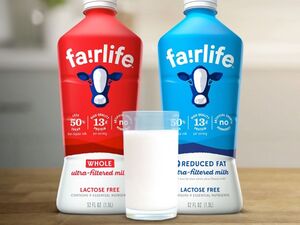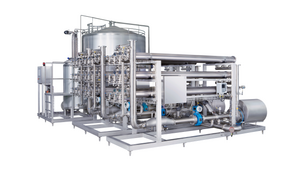Course:FNH200/Projects/2023/Regular vs. Ultrafiltered Milk
Introduction
Milk is a regularly consumed beverage derived from cattle. Milk is commonly consumed amongst western countries, but also consumed globally. Some benefits of milk consumption are nutritional benefits, however, it may not be suitable for all people due to allergies or intolerances. Recently, ultrafiltered milk has gained popularity due to a higher concentration of protein and lower concentration of sugar per serving.
Regular Milk
In BC cows are generally milked 2-3 time a day. The milk is then stored in temperature regulated containers. Every other day the milk is then trucked to a processing plant. The milk is kept at below 4 degrees and the truck driver is a certified milk grader who inspects the milk and takes a sample which is sent to a lab. The lab tests the sample to ensure it meets regulation standards. Once the milk arrives at the processing plant it is then tested again for antibiotics and growth hormone. The milk is then pasteurized. The pasteurization process for milk involves it being heated to 72 degrees for 16 seconds and then being cooled to 4 degrees.[1] After pasteurization milk is put through a separator which removes the cream from the milk. Cream is then re-injected into the milk to create different variations of milk (skim, 1%, 2% etc). Then, milk is homogenized which reintegrates the cream into the milk and ensures an even distribution of fat is achieved. The milk is then bottled and then sent to stores.[1]
Ultrafiltered Milk
The production of ultrafiltered milk involves further filtration of regular milk to decrease the lactose content.
Step 1: Semi-porous membrane filtration
According to BC Dairy, filtration is done by passing milk over a semi-porous membrane that passes milk permeate through while leaving milk retentate behind. The byproduct permeate contains all the natural lactose, fats, vitamins, and minerals in regular milk, and the milk retentate is the retained fluid concentrated with leftover milk protein.[2]
Step 2: Lactase Enzyme and Dilution
The retained retentate is then re-diluted with water and lactase enzyme, which breaks down any remaining lactose into glucose and galactose for easier digestion.[3] Filtration membranes can vary in purpose depending on whether the manufacturer wishes to retain more milk protein or lactose.[4] The dairy company Fairlife, for example, uses lactase enzyme to break down any remaining lactose in the filtered milk, whereas Joyya filters lactose with the processing membrane.[5]
Step 3: Microfiltration and Ultra-pasteurization
In Canada, ultrafiltered milk is also microfiltered and ultra-pasteurized to eliminate any spoilage-causing bacteria and to extend shelf-life.[6] Studies show, however, that bifidobacteria (a probiotic culture naturally found in human gastrointestinal tracts and dairy products) can still survive. This means that ultrafiltered milk is functional for the production of fermented products regardless of its extensive microbial filtration process.[6]
Step 4: Homogenization
After microfiltration and ultra-pasteurization, the ultrafiltered milk is then homogenized to fully emulsify any remaining milk fat droplets before being sent off for packaging.
Processing differences
The differences between regular milk and ultrafiltered milk can be summed up in three key components: sweetness, filtration, and durability.
Ultrafiltered milk is typically sweeter compared to regular milk due to the hydrolysis of lactose into glucose and galactose with the addition of lactase during its manufacturing process. Both glucose and galactose rank higher than lactose on the sucrose sweetness index, resulting in a sweeter taste. Though ultrafiltered milk is lower in fat and sugar, however, it is still the same amount of calories as regular milk due to its high protein composition.[7]
Ultrafiltered milk follows additional processing steps in comparison to regular milk such as membrane filtration, microfiltration and ultra-pasteurization. While regular milk is simply pasteurized and homogenized upon several inspections, ultrafiltered milk must undergo several lactose-dissipating processes before packaging takes place. The additional steps in ultrafiltration may account for ultrafiltered milk’s higher pricing compared to regular milk.[7]
Ultrafiltered milk also tends to last longer than regular milk due to its pasteurization at higher temperatures. Ultrahigh-pasteurization kills close to 99.9% of all bacteria present in the milk, prolonging shelf life up to approximately 60 days.[8] However, ultrafiltered milk will spoil at the same rate as regular milk upon opening the bottle.[2]
Nutritional differences
Regular milk nutritional content:
Proteins: Approximately 3.4% protein content (mainly casein and whey proteins).
Fats: Around 3.25% in whole milk, with variations for reduced-fat options.
Carbohydrates: About 4.8% carbohydrates, primarily lactose.
Minerals: Contains essential minerals like calcium and phosphorus.
Vitamins: Includes vitamins like A, D, and B12.
Ultrafiltered milk nutritional content:
Proteins: Increased protein content, often up to 50% more than regular milk. This is due to the concentration of proteins during filtration.
Fats: Can be similar to regular milk or reduced, depending on the product formulation.
Carbohydrates: Reduced carbohydrate content due to partial removal of lactose. Some brands claim up to 50% less sugar.
Minerals: Some minerals may be reduced through the ultrafiltration process.
Vitamins: Can be similar to regular milk, though some brands add vitamins to compensate for losses during processing.
Lactose: The lactose content in ultrafiltered milk is reduced to some extent due to the filtration process, but it still contains some lactose.
The main chemical differences are in the concentration of proteins and reduction of lactose. The fat content, vitamin, and mineral balance can also be adjusted in ultrafiltered milk depending on the manufacturer's goals.
Environmental and Health Considerations
Environmental Impact
The ultrafiltration process might consume more energy compared to traditional milk processing, which could contribute to a higher carbon footprint.[9] The filtration process for ultrafiltered milk may also require more water usage.[10] If environmental concerns are a priority, consumers might want to research brands and their respective environmental practices.[11]
Health Considerations
Ultrafiltered milk may contain added vitamins and minerals to balance the altered nutrient content, or stabilizers to maintain the texture. Examining the ingredient list might be important for those with specific dietary needs or preferences. Furthermore, individuals with specific allergies or sensitivities may need to examine the exact formulation of ultrafiltered milk to ensure compatibility with their needs, particularly lactose. Intolerance response to either dairy or lactose may vary depending on the brand of ultrafiltered milk and how much lactose the manufacturers decided to maintain. Depending on specific dietary guidelines, such as a ketogenic diet or low-fat diet, one type of milk might be more suitable than the other.
The rise of milk alternatives, such as oat milk, almond milk, soy milk, and others, can be attributed to a combination of factors including dietary preferences, health concerns, environmental considerations, and the desire for diverse options. While regular cow's milk remains a significant food commodity, the popularity of milk alternatives has indeed grown due to changing consumer preferences and various associated benefits.
Exam Question
Why does ultrafiltered milk generally have a longer shelf life than regular milk?
a) Tetra Paks are used to store ultrafiltered milk
b) Ultrafiltered milk is pasteurized at a higher temperature
c) Preservatives are commonly added to ultrafiltered milk
d) Ultrafiltered milk is produced closer to consumers reducing transportation time
e) Higher quality cows are milked for ultrafiltered milk
Answer: b
Milk is commonly wasted as a result of it going bad, so knowing that ultrafiltered milk has a longer shelf life could help to reduce food waste. Additionally, the question relates to content covered in lesson 6.
- ↑ 1.0 1.1 "Milk's Journey to You". 2018.
- ↑ 2.0 2.1 "What is Ultrafiltered Milk?". 2019.
- ↑ Alfaro, Danilo (2022). "What Is Ultra-filtered Milk?".
- ↑ "Joyya".
- ↑ "Fairlife".
- ↑ 6.0 6.1 "Growth Characteristics of Bifidobacteria in Ultrafiltered Milk". Journal of Dairy Science.
- ↑ 7.0 7.1 Muinos, Lacey (2022). "Is Ultra-Filtered Milk Actually Better for You Than Regular Milk?".
- ↑ "Why Does Lactose Free Milk Last Longer?". 2022.
- ↑ "Characterisation of a cell-free supernatant obtained from cultures of Enterococcus faecalis DBFIQ E24 with antagonistic activity against bacteria, yeasts and moulds".
- ↑ "Water Usage".
- ↑ "Sustainable Food Processing".

